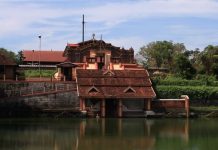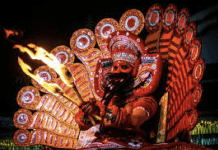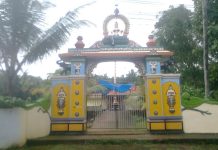Swaminatha Swamy Temple, also known as Swamimalai Temple, is a renowned Hindu temple located in Swamimalai, 5 km from Kumbakonam, on the banks of Kaveri river in Thanjavur District, Tamil Nadu, India. This ancient temple is dedicated to Lord Murugan, also known as Swaminatha Swamy, the son of Lord Shiva and Parvati.
The temple is one of the six abodes of Lord Murugan, known as Arupadai Veedu, which are the most sacred pilgrimage sites for Murugan devotees.

Legend of Swaminatha Swamy Temple
According to the legend, long ago, in the abode of the Gods, there was a dispute between two powerful deities: Brahma, the god of creation, and Muruga, the son of Shiva. Muruga was offended by Brahma’s disrespectful behavior towards him and challenged him to explain the meaning of the sacred “Om” mantra, which Brahma had used to create all living beings. However, Brahma was unable to explain its significance, and Muruga punished him by imprisoning him.
The absence of Brahma caused great concern among the other gods, who pleaded with Vishnu to intercede on his behalf. However, Vishnu was unsuccessful in convincing Muruga to release Brahma. Finally, Shiva himself appeared before Muruga and requested his son to release Brahma.
Muruga agreed, but only on the condition that he be allowed to teach Shiva the true meaning of the “Om” mantra. Shiva humbly agreed, and Muruga explained the profound significance of the mantra, thus earning the name “Swaminatha Swami,” the teacher of Shiva.
In honor of this legend, a magnificent temple was constructed on a hilltop, with Muruga’s shrine at the summit and Shiva’s at the base. The temple remains an important pilgrimage site, attracting devotees from all over the world who come to seek Muruga’s blessings and to pay homage to the enduring power of the sacred “Om” mantra.
Architecture
The Swaminatha Swamy Temple is known for its beautiful architecture and intricate carvings. The temple has six levels, each representing a stage of spiritual evolution. The stairs leading to the top of the temple are said to represent the steps one must take to reach enlightenment. The temple consists of three precincts and three gopurams. The sixty steps leading to the shrine are named after the sixty Tamil years. The first precinct contains the images of Dakshinamurthy, Durga, Chandikeswarar, and the festival image of Swaminathaswamy. The image of Swaminathaswamy is 6 ft tall. There are golden armours, golden crowns and a diamond lance for Swaminathaswamy. The second precinct houses a marriage hall and the temple’s chariot, while the third precinct is located on the hillock around the Swaminathaswamy shrine. Unlike other Murugan temples, where peacock is sported axial to the image of the presiding deity, an elephant is seen in front of Murugan in the temple. The temple is maintained by the Hindu Religious and Charitable Endowments Department of the Government of Tamil Nadu and is a popular pilgrimage site.

Festivals
The temple celebrates three festivals every year, including the highly anticipated Vaikasi Visagam festival, which draws in throngs of devotees from both near and far.
Temple timings:
The temple has six daily rituals. The temple opens from 5:30 a.m. to 12:00 pm and 04:00 pm to 9 p.m.
How to reach Swaminatha Swamy Temple
Swaminatha Swamy Temple is 5 km from Kumbakonam. Kumbakonam is a town in the state of Tamil Nadu, India. It is well-connected by road, rail, and air.
By Air
The nearest airport is the Tiruchirapalli International Airport, which is around 90 km (56 miles) away. From the airport, you can hire a taxi or take a bus to Kumbakonam.
By Rail
The town has its own railway station, Kumbakonam Junction, which is well-connected to major cities in India. Trains from Chennai, Bangalore, Mumbai, and Delhi stop at this station. There are also regular bus services to Kumbakonam from nearby cities like Chennai, Thanjavur, and Tiruchirapalli.
By Road If you are traveling by car, Kumbakonam is located on the National Highway 36, which connects Chennai with Madurai. It is also connected to other major cities in Tamil Nadu via state
























































